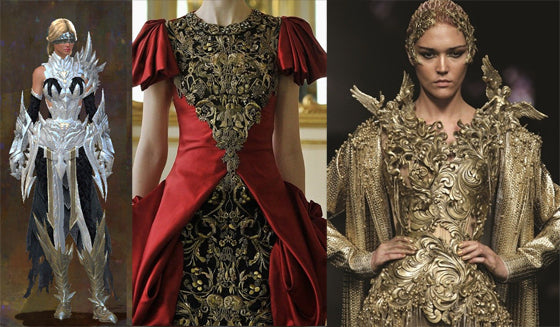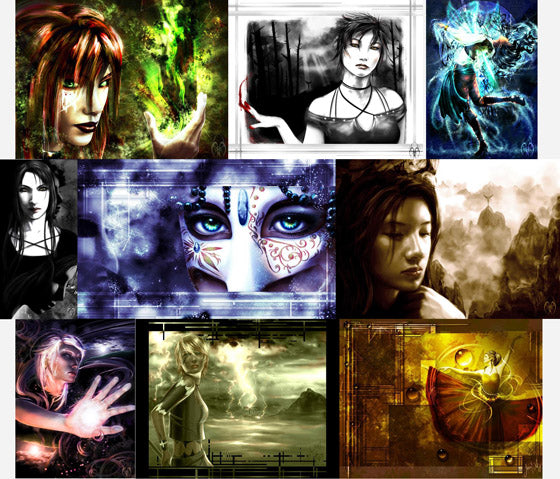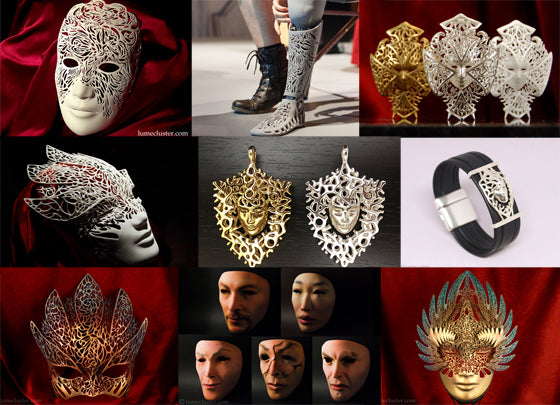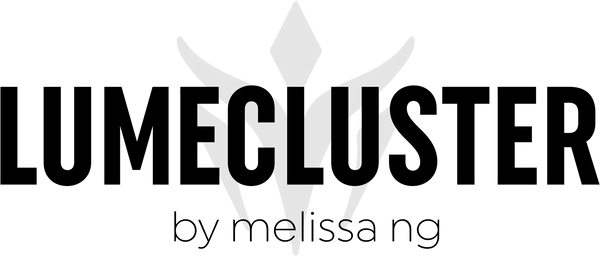
Read part 2: Painting, finishing, and final armor preview
Read part 3: Geek & Sundry photoshoot and video of armor
_____________________________________________
“People are starting to look less at where you went to school, and more at what you’ve created.” —Chase Jarvis
Let’s be honest. Have you ever looked at someone else’s art or creations and thought “I wish I could do that but…”
“I don’t have the right credentials,
I don’t have the relevant degrees or education,
I don’t have all the right tools or materials,
I don’t have a natural talent for it,
I can’t start learning now because I’ll be too slow,
I have no idea where to start,
it’s too hard for someone like me,
it looks impossible…”
It’s a shame how many people stop before they even start. I know I’ve thought each of these at least a few times in my life. In fact, as a self-taught artist with no art, architecture or design degrees and no history involved in tech, I used to belittle myself for not having the “proper credentials” and abandoned doing art for nearly 5 years (you’ll hear more about that later). I used to look at all the other artists I admired and despaired over how I’d never be as good as them. And I was being ridiculous. Why?
Because I was wasting time comparing myself with someone else’s results…someone I knew nothing about. I was looking at where they were going in life and forgetting about paying attention to my own. It wasn’t until October 2013 that I finally stopped comparing my experience with others that I started paying attention to my own expectations and interests that were true to myself—my love for masks.
3D printed Dreamer Masks Empower, Breakthrough, and Transformation
While everything didn’t magically get easier, discovering what I had an intense interest in made hours of work feel like nothing. And 3D modeling/printing became a vehicle that could get me closer to creating something I loved.
But too often, many of us get stuck focusing on where we are lacking rather than on what we can do to overcome existing obstacles. We look at those who are more successful and think they know some secret or some magic that we don’t.
“Perfection is not interesting. Copying people is not interesting. You will never make a career trying to be like everybody else.” –Felicia Day
When we focus on someone else’s journey instead of our own, we may encounter three silent killers of creativity. “It’s so much easier for them,” “this shouldn’t be so hard,” and “I’ll never be as good as them.” When the going gets tough, it’s easy for these phrases to slip out. What these three have in common is that they put a focus on someone else’s end result without considering the struggle that came before it.
Yes, we all love experiencing the magical wonder when we see the finished piece from someone we admire. But it’s even more fun when we get to see and appreciate the work that went behind it. Because when we dispel the magic and see what it takes, it makes it feel more real and gives us hope that we might be able to make something awesome too.
So, I created the Dreamer Regalia project in collaboration with Shapeways (the world’s leading 3D printing marketplace and community) to create something magical-looking while sharing my entire not-so-very-magical process every step of the way. We hope it can inspire you to fight for your creative ambitions and to believe you have what it takes to make something amazing.
My personal hope is that, as a self-taught artist who is still learning more about myself everyday, people will also stop using the lack of “proper artistic credentials” as a put-down on other people’s (or their own) creativity. Everyone has the freedom to take their imagination to greater heights.
A Lumecluster & Shapeways Collaboration: Documenting & 3D printing the Dreamer Regalia armor for actor Felicia Day.
“Tech rewards innovation in a way that Hollywood would never do. Innovation is financially rewarded in tech. If you’re the first and the most inventive, that’s where people will gravitate. Where consumers will gravitate. But in Hollywood, it’s a risk averse business. It’s a business of proven commodity. But tech is different…I want to be surprised in life, I want to see where things can go, I want to see possibilities and things I’ve never seen before, or make things that are unexpected.” —Felicia Day
When it comes to someone who has taken her imagination to amazing heights, I can think of no better person than Felicia Day. Day is an actor, author of New York Times Bestseller You’re Never Weird on the Internet (Almost), avid gamer, geek advocate, producer (Knights of Good), and entrepreneur (Geek and Sundry). She has appeared in numerous mainstream films and shows like “Buffy the Vampire Slayer,” “Supernatural” and “Eureka.”
However, Day is best known for her work in the web video world. To name a few, she has co-starred in Joss Whedon’s Internet musical “Dr. Horrible’s Sing-Along Blog,” created and starred in the award winning web series “The Guild,” and wrote and starred in the Dragon Age web series “Dragon Age: Redemption.” Most recently, Day appeared in Alan Tudyk’s record-setting crowdfunded web series “Con Man” and will also be appearing in another record-setting crowdfunded series, “Mystery Science Theater 3000.”
Day encourages people, “Embrace your weird,” which is also a campaign to stop bullying. She fights for diversity in gaming, empowers women to be more proactive, always seeks new challenges, constantly breaks away from the norm, and empowers people to fight for their dreams. Shapeways and I believed Day was the perfect person for the Dreamer Regalia armor.
So, what exactly is the Dreamer Regalia armor?
The Dreamer Regalia symbolizes the protection for our dreams and is being created in honor of the Dreamer within each of us. The Dreamer that wants to give life to the imagination, make a difference, change things, push boundaries, and not conform to the status quo. The culture of creativity is constantly growing and branching out in new ways everyday. And the best part is we are all free to take part.
To reiterate my earlier point, by sharing my creative process, Shapeways and I hope this can inspire you to discover what dreams or ideas light you up and to give yourself room to appreciate your own personal creative journey.
If you have a creative dream/idea that you’re willing to lose sleep over, experiment with, make mistakes, obsess about, and constantly push yourself to expand your skills, then you may be already onto something.
Dispelling the magic: Documenting the Dreamer Regalia creative process with photos, timelapse videos, and blog posts.
“Now there’s a lot of talk about the sharing economy…we trade knowledge. That is really, really important. There is nothing that makes me angrier when somebody does something beautiful and you ask how it’s done and they say ‘It’s a secret.’ No secrets! What are you protecting? Nobody is gonna take your technique and then steal your idea. Nobody has a monopoly on being you. And if you think that your technique is what makes you interesting, then you’re being ridiculous. So share your techniques, because when you do, someone’s gonna come back to you with a better way of doing it and you’re gonna learn something from them.” —Adam Savage, Mythbusters
You’ll see how the design begins, how it evolves, and how I finally reach my final iteration. Plus, you’ll get to see it all hand painted and finished to look like intricate golden armor. Overall, you’ll see what it takes me to get to the final result.
Please note that this is NOT a how-to series and I am NOT saying I know everything there is to know about 3D modeling and 3D printing. This is an observation of my creative process. Keep in mind that I am also designing all of this on the side while managing my other companies with my sisters. Since I started a few weeks ago, here’s what I’ve done so far…
10 hours — Research, weighing risks, and inspiration gathering
How long I take to do my research depends on how much I may already know on the subject, the scale of the design, and the overall complexity of the project (and this is pretty complex…). Being a gamer like Felicia Day, I decided to lean toward doing something Guild Wars 2-inspired (a massively multiplayer online role-playing game, which Day had also done some voice acting for), foxes (because Felicia really likes foxes), Alexander McQueen, and Tex Saverio. Like for my Dreamer Masks, I also got inspiration from Chinese carvings. As you may have guessed, this isn’t really functional armor. It’s mostly for looks.

Chinese carved lacquer, stone, wood, ceramic artwork that I grew up seeing in the Ng family household.
From left to right: Guild Wars 2 in-game armor and designs by fashion designers Alexander McQueen and Tex Saverio
I had to take a lot of time weighing the risks since creating this armor is a completely new (and large) challenge for me. Sure, I’ve printed many pieces already with great success (and without prototype prints), but this is on a totally different scale and I have to be extremely careful about my design choices. Some questions I’ve been asking myself every single moment as I progress:
What do I already know from my past experience and how can I apply that knowledge to ensure that this one-shot print is a success? Since this will be the first time I’m recording my 3D modeling and making timelapses, how much should I practice so I can be comfortable enough without freezing up when I finally do need to record my work? Have I laid out my design goals well enough so that I can easily pace myself as I’m recording the timelapses?
If I design it this way, will the armor have enough support or will it be too rigid and lack flexibility? What can I do with the design to avoid making this armor look awkward and clunky? How can I design it in a way that looks both elegant and strong and stays within the budget? How does the design symbolism match Lumecluster, Shapeways, and Felicia Day’s missions and philosophies? Does this design match Felicia’s interests and aesthetic? How can I make this design flow and make it easy for Felicia to move around?
Will this design make it hard for me to maneuver when I need to paint and finish it? Would the paint job take away too much of the material’s flexibility in this location of the armor? If I want to put LEDs here, how much space would I need and where would the wires or microcontroller(s) go?
12 hours — Armor sketches
Like doing my research, how long I take to do my sketches depends on how much I may already know on the subject, the scale of the design, and the overall complexity of the project.
10 hours — Modeling the armor base shape and design in Blender
13 hours — Armor pattern doodle in ink pen
3D scanning company, Cokreeate, provided the 3D scan of Felicia Day
Cokreeate is an LA-based 3D scanning and 3D printing company that helps people bring their ideas and imagination to life. They have scanned folks like Stan Lee, Larry King, Christina Milian, and Ty Simpkins. You can see more of their work on their Instagram, Facebook, and Twitter.
Cokreeate used the Artec Eva scanner and Artec Studio 10 software to create a highly detailed 3D scan. However, in the timelapse video below, I had to decimate and simplify Felicia’s 3D scan mesh since my crap computer can’t handle a mesh with this amount of detail.
16 hours — Editing base design, adjusting armor to Felicia Day’s 3D scan, and beginning of pattern application (chest) in Blender
5 hours —Editing the three timelapse videos
Most of the time was spent struggling to pick songs.
42 hours — Writing this blog post
While I enjoy writing, organizing my thoughts and experiences in a way that’s concise and interesting is still pretty challenging for me. I get mentally exhausted a lot faster than when I’m creating new designs because my mind tends to wander down too many rabbit holes. But after numerous outlines and several scrapped article drafts (5 to be exact), I finally came up with this blog post.
And there’s still a lot more to come… Heck, the design is only 20% complete, haha.
-
(UPDATE) See all 3D modeling timelapse videos by clicking here or watching the playlist below. You can also see the finished armor here or check out the final photoshoot of the Dreamer Regalia armor.
- 3D printing in Shapeways material white, strong & flexible plastic
- Resin casting the red gem(s)
- Painting and finishing
- Installing LEDs (possibly)
 The design has changed a few times already. And there is still a long way to go…
The design has changed a few times already. And there is still a long way to go…
As I continue, most of my posts will be going up on my Facebook, Instagram, and Twitter.
At the end, we’ll pull it all together into a more comprehensive article for your convenience.
I won’t lie. I’ve been feeling both incredibly excited and terrified about this project. Excited because I get to make something for someone I have immense admiration and respect for, and I get to collaborate with a company I love. Terrified because I struggle between fluctuating moods of either extreme confidence or severe inadequacy and I am afraid to be judged, rejected, and torn apart about my technique, style, and overall approach. Hey, I’m still human.
Despite these fears, more than anything, I hope you remember how important it is to find the creative approach that works best for you and be willing to grow in new ways at the same time.
So, to wrap things up, let me tell you a little bit about my artistic and 3D design “credentials.”
“I can’t learn any skills unless I have a project to learn with. I need a goal. I need something. I need to know something. I need the thing I’m trying to attain. I can’t learn to weld just by someone showing me that it should sound like frying eggs and you set the dials like this….Always try to find a project that will get you interested in the thing you want to build.” —Adam Savage, Mythbusters
Ever since Lumecluster and my 3D printed art became a more serious part of my life, people have been asking me about how I got started. The comments often begin with, “So, what art school did you go to? Do you have a background in fashion or design? Do you have a background in architecture or animation or something?”
When I tell them that I didn’t go to an art school or have a design background or have a history involved in tech, I usually get four kinds of reactions:
- They think I’m lying and are convinced “you can’t learn this stuff on your own.” To be fair, 3D printing is still pretty mysterious and intimidating to a lot of people.
- They start looking at me skeptically and feel they have a right to quiz me on how much I don’t know.
- They brush me off as someone who is “naturally talented,” which is kind of a backhanded compliment since it implies that this all came to me with little effort. I know plenty of people who are 10 times more skillful than me, and their ability looks effortless only because they commit themselves to relentlessly hone their skills in something they love.
- They express surprise/relief that a self-taught artist can pursue 3D printing pretty seriously.
So, what’s my background? I have a bachelor of arts in communication and media studies and a master of arts in public communication from Fordham University. I also have a professional certificate in public relations from New York University. But ever since I was a child, I always wanted to create art. The problem for me was finding a medium I could stay in love with.
What’s my art and 3D design education? Well, over a span of 18 years, I would draw whenever I had time. By October 2013, I’d already played around with several mediums…except 3D printing. Turns out 3D printing really captured my attention. But it wasn’t until 2014-2015 that I started developing a style that I might be able to call my own.
My hope is that, by sharing how my art has changed over the years (and will likely continue to evolve), we’ll remember that growing and becoming better artists takes persistence and enough self awareness to know when to keep going and when to quit and move on. In other words, you’re perfectly normal if you don’t get it “right” the first time.
1997 – 1999
I grew up reading a lot of fantasy novels and playing video games. My sister and I used to dress up and pretend to be a wizard or warrior and we always had magical duels (no one ever got hurt). So, it’s no surprise that our childhood playtime influenced my artwork over the years.
2000 – 2003

2004 – 2006
2007 – 2011
I was a self-pitying mess and figured I’d never be good enough so I abandoned art. But by giving up on creating art, I became extremely depressed. This was also around the time my sisters and I started our own small business (with storefront and all). It was an extremely stressful time that taught me a lot about myself, my strengths, and my weaknesses.
2012 – 2013
I was super depressed and decided I desperately needed to bring art back into my life again. I created Lumecluster back in 2012 primarily as some scrappy blog where I thought I could share what I’d learned as a small business owner. At the same time, it gave me a good excuse to start drawing again. My early Lumecluster blog posts were accompanied with ink doodles of my early doodled “Dreamers.” Sadly, I was quickly falling out of love with ink drawing. But instead of giving up again, I decided to experiment with more paints, markers, paper cutting, and laser cutting…but I got bored of them fast. By October 2013, I decided to give 3D printing a shot and quickly became obsessed with the possibilities that the other mediums could not offer me.
2014 – 2015
By January of 2014, I decided I’d stick it out a little longer with 3D printing and see where I could go. I talk more about how I got started in 3D printing in this blog post and my Shapeways interview. Within less than a year of being in the 3D printing arena, I’ve worked on projects from helping with designing a 3D printed prosthetic leg for the courageous Natasha Hope-Simpson to designing 3D printed masks for a JiHAE / Leonard Cohen music video starring The Walking Dead’s Norman Reedus. I’ve also been featured on sites like 3D Printing Industry, 3DPrint.com, TED Blog and Forbes.
While my art has shifted, there is one thing that hasn’t changed since I was a child…I’ve always wanted to make or own some kind of armor. And now here I am creating art I love to make.
Sure, if you want to be a lawyer or doctor or something, I’d probably worry about proper credentials.
But in the end, if you’re out to make, tinker, design something amazing, fun, weird or beautiful, who’s to stop you from trying except yourself?
“But the heart of my story is that the world opened up for me once I decided to embrace who I am—unapologetically. My story demonstrates that there’s no better time in history to have a dream and be able to reach an audience with your art. Or just be as weird as you want to be and not have to be ashamed. That lesson’s just as legit.” ―Felicia Day, You’re Never Weird on the Internet
Whatever it is you want to make, there are more available resources than ever before right at our fingertips. For example, if you want to try 3D modeling, you have nice resources like Shapeways 3D printing tutorial for beginners and an awesome list of free and commercial 3D design software.
Nowadays, “proper credentials” aren’t even enough anymore. And while having persistence and perseverance is a major plus, that alone won’t be enough either without some idea or vision to build upon. Knowing yourself and what lights you up has more influence than someone who only has the technical chops. To expand on this, I’d like to share the words of concept artist, Noah Bradley:
“If you go through art school and you do every assignment well, you do every single assignment your teachers give you and you get an A on everything, you will not make it as an artist. You will fail. You will not be good enough, you will not have a good portfolio coming out of art school. You won’t make it. It’s the stuff you do on your own that really makes a difference. It’s the stuff that you learn on your own. It’s all that extra effort that really pushes you to that level where you can actually make it….
A lot of people get told to do stuff. And the thing about it is that art is immensely personal. It has to come out of you. You have to know what YOU want to do. And that’s a terrifying thing to realize. For the rest of your life, you’re gonna have to come up with what you want to do. And that’s intimidating for a lot of people. People want to be told what to do…it’s comfortable, it’s easy…I encourage people to do their own work because it lets you explore what you really want to do.” ― Noah Bradley (in an interview on The Good Life Project)
I wish I could say that fighting for your dreams is a simple matter of doing A, B, and C. But there is no magic bullet and I’m not one for sugar coating. The reality is that pursuing your creative ambitions will always require an investment of your time, money, and endless dedication. After all, nothing worthwhile ever comes without sacrifice. Anyone who says it’s easy is either lying or not telling the whole story.
If you want to 3D print, make, write, paint, design something, waiting your life away for the “right” credentials or the “right” materials or the “right” moment to finally start won’t help you actually make anything. It’s what you choose to make right now that matters. Becoming good at anything will always require you to be a beginner at some point…until you’re not anymore.
So, I’d like to leave you with a question:
What do you dream (and geek out) about making and what’s ONE step you can take right now to start fighting for it?
<3 Melissa
P.S. Click here to read Part 2 of the blog series where I share the painting/finishing of the armor.

